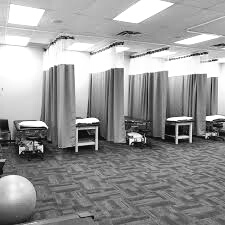Although cubicle curtains have always been a feature of large physiotherapy departments, they have a relatively recent history. Curtains were rarely used by doctors who saw patients in their consulting rooms, and images of early hospitals and World War I rehabilitation centres show patients in large open rooms, with little concession to privacy.
Cubicles and their curtains became more common with the advent of organised healthcare after the 1930’s. Manufacturing principles began to be applied to healthcare, with large departments of static professionals treating large numbers of patients in uniform spaces. Each cubicle had a bed, a chair, and sometimes an arm table, but little else.
Curtains gave people a degree of privacy, but also allowed department heads and matrons to listen in and supervise from a distance. They were cheap, mobile partitions, designed to maximise the use of space, and the action of opening and closing were excellent devices for indicating the beginning and end of the therapy session. The cubicle allowed therapists to perform techniques that might be inappropriate in public spaces, and patients would often whisper confidentially inside the cubicle. The limited space they offered often created problems when large equipment was used, and little thought went into the design of the curtains themselves, which were often drab and uninteresting. But they remain a standard feature of large departments today.
Description provided by David Nicholls of New Zealand.

